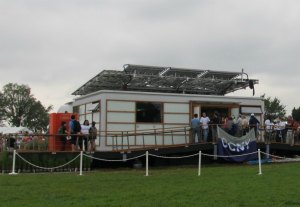
We’ve got a little bit of solar power going in Verona: A business, a house, and some town buildings. But if you want to get a true sense of solar energy’s possibilities, you’ve got to get yourself to Washington, D.C. before the sun sets on October 2.
That is where the U.S. Department of Energy is running its bi-annual Solar Decathlon, a competition between universities in the United States and around the world to show the possibilities of solar-powered dwellings. And this year, much more than the last competition in 2009, you can see how a real family could live in a solar house. This year, the teams were allowed to build houses as large as 1,000 square feet–still small by Verona standards–but enough for a living room, kitchen/dining space, two bedrooms and, for the most part, a really luxurious bathroom. Some of our favorite houses this year spread their solar wings even further, with indoor/outdoor living on expansive porches, second stories and even a solar garage for the car.
Each of the houses in the competition is graded by a team of experts on their energy production and usage. There are, as you might expect, plenty of solar panels on roofs, but also solar thermal walls and panels that can capture the sun’s rays on top and reflected sunlight underneath. More than a few houses had systems to gather rainwater for irrigation and to filter the junk out of washwater for that purpose too. The college students who lead the tours of their houses were equally proud to show off their architecture and their mechanical systems.
Just as in “Dancing With The Stars”, fans get to vote for their favorite houses too. As of Monday night, September 26, the University of Maryland’s WaterShed house led the overall standings, but Appalachian State (my favorite) topped the People’s Choice vote.
When the competition is done, some of the houses will go to private owners, like Team New Zealand’s. Some will go on display: Team New Jersey’s sturdy cement beach house will be set up permanently at the Liberty Science Center in the spring. And some just may become prototypes for some much smarter residential construction in the future.
[nggallery id=146]

